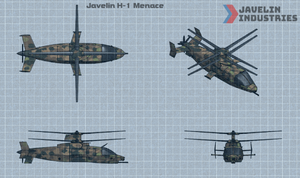Javelin H-1 Menace: Difference between revisions
From MicrasWiki
Jump to navigationJump to search
No edit summary |
Continuator (talk | contribs) mNo edit summary |
||
| (5 intermediate revisions by 3 users not shown) | |||
| Line 14: | Line 14: | ||
| data4 = {{AN|1699}} | | data4 = {{AN|1699}} | ||
| label5 = Number built | | label5 = Number built | ||
| data5 = | | data5 = 240 | ||
| label6 = Designed | | label6 = Designed | ||
| data6 = {{AN|1696}}-{{AN|1699}} | | data6 = {{AN|1696}}-{{AN|1699}} | ||
| Line 54: | Line 54: | ||
| label25 = Armaments | | label25 = Armaments | ||
| data25 = * 1x 20mm three-barrel rotary cannon, 500 rounds | | data25 = * 1x 20mm three-barrel rotary cannon, 500 rounds | ||
* Internal bays: 6x JAV 93 missiles or 24x 81mm JAV 30 Seeker guided rockets | * Internal bays: 6x [[Javelin_Industries#Air_defense_systems_and_missiles|JAV 93 Strong Girl missiles]] or 24x 81mm [[Javelin_Industries#Air_defense_systems_and_missiles|JAV 30 Seeker]] guided rockets | ||
* Optional stub wings : 8x JAV 93 missiles or 32x 81mm JAV 30 Seeker guided rockets | * Optional stub wings : 8x [[Javelin_Industries#Air_defense_systems_and_missiles|JAV 93 Strong Girl missiles]] or 32x 81mm [[Javelin_Industries#Air_defense_systems_and_missiles|JAV 30 Seeker]] guided rockets | ||
| label26 = Avionics | | label26 = Avionics | ||
| data26 = *Multispectral Target Acquisition System (MTAS) | | data26 = *Multispectral Target Acquisition System (MTAS) | ||
| Line 65: | Line 65: | ||
*Advanced Infrared Countermeasure (AIRCM) System | *Advanced Infrared Countermeasure (AIRCM) System | ||
}} | }} | ||
Beginning in {{AN|1708}}, the {{PAGENAME}} would begin to replace the turboprop light attack aircraft which had previously the mainstay of close air support for the [[Federal Forces of Nouvelle Alexandrie]]. Full scale production of the attack rotorcraft began in {{AN|1704}} and would see 240 airframes completed by {{AN|1708}}. | |||
In common with many designs introduced by [[Javelin Industries]], the {{PAGENAME}} had its genesis with proposals first put together during the late 1690s, but which would not fully enter into serial production until the manufacturing capacity of the still nascent Federation caught up to the ambitions of its government during the early decades of the eighteenth century ''[[after Norton]]''. | |||
[[Category:Military aviation]] | |||
[[Category:Javelin Industries]] | |||
Latest revision as of 12:15, 21 July 2023
 Javelin H-1 Menace | |
| Type | Reconnaissance and attack helicopter |
|---|---|
| Place of origin |
|
| Introduced | 1699 AN |
| Number built | 240 |
| Designed | 1696 AN-1699 AN |
| Manufacturer | Javelin Industries |
| Length | 12.28 m |
| Height | 4.7 m |
| Disc area | 113 m2 |
| Main rotor diameter | 12.0 m |
| Empty weight | 3,400 kg |
| Fuel weight | 700 kg |
| Max takeoff weight | 6,500 kg |
| Powerplant | 1x Javelin turboshaft engines, 2,250 kW |
| Propeller | 6-bladed variable-pitch, 2.5 m diameter |
| Maximum speed | 240 knots (440 km/h) |
| Combat radius | 275 km w/ 2 hour loiter |
| Cruise speed | 220 knots (410 km/h) |
| Ferry range | 2,200 km |
| Service ceiling | 6,100 m |
| Rate of climb | 28 m/s |
| Roles |
|
| Armaments |
|
| Avionics |
|
Beginning in 1708 AN, the Javelin H-1 Menace would begin to replace the turboprop light attack aircraft which had previously the mainstay of close air support for the Federal Forces of Nouvelle Alexandrie. Full scale production of the attack rotorcraft began in 1704 AN and would see 240 airframes completed by 1708 AN.
In common with many designs introduced by Javelin Industries, the Javelin H-1 Menace had its genesis with proposals first put together during the late 1690s, but which would not fully enter into serial production until the manufacturing capacity of the still nascent Federation caught up to the ambitions of its government during the early decades of the eighteenth century after Norton.